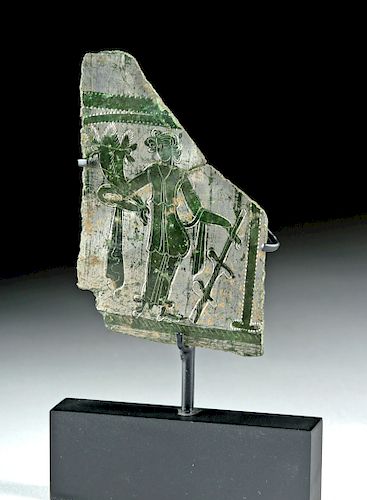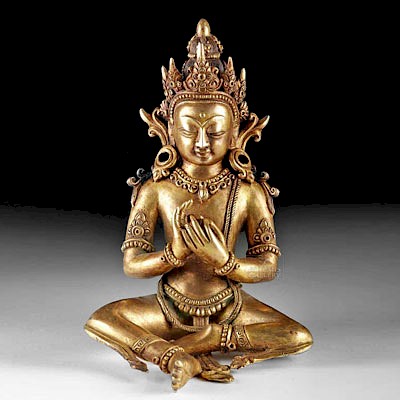Roman Tinned Bronze Chariot Adornment - Fortuna
Lot 23a
About Seller
Artemis Gallery
686 S Taylor Ave, Ste 106
Louisville, CO 80027
United States
Selling antiquities, ancient and ethnographic art online since 1993, Artemis Gallery specializes in Classical Antiquities (Egyptian, Greek, Roman, Near Eastern), Asian, Pre-Columbian, African / Tribal / Oceanographic art. Our extensive inventory includes pottery, stone, metal, wood, glass and textil...Read more
Estimate:
$1,100 - $1,650
Absentee vs Live bid
Two ways to bid:
- Leave a max absentee bid and the platform will bid on your behalf up to your maximum bid during the live auction.
- Bid live during the auction and your bids will be submitted real-time to the auctioneer.
Bid Increments
| Price | Bid Increment |
|---|---|
| $0 | $25 |
| $300 | $50 |
| $1,000 | $100 |
| $2,000 | $250 |
| $5,000 | $500 |
| $10,000 | $1,000 |
| $20,000 | $2,500 |
| $50,000 | $5,000 |
| $100,000 | $10,000 |
| $200,000 | $20,000 |
About Auction
By Artemis Gallery
Jun 6, 2019
Set Reminder
2019-06-06 10:00:00
2019-06-06 10:00:00
America/New_York
Bidsquare
Bidsquare : VARIETY AUCTION | Ancient & Ethnographic
https://www.bidsquare.com/auctions/artemis-gallery/variety-auction-ancient-ethnographic-4182
Around the world & back in time - be amazed at the treasures you will find. Antiquities from Egypt, Greece, Italy and the Near East, Asian, Pre-Columbian, African / Tribal / Oceanic, Native American, Spanish Colonial, Russian Icons, Fine Art, much more! All categories, all price ranges...all legal Artemis Gallery info@artemisgallery.com
Around the world & back in time - be amazed at the treasures you will find. Antiquities from Egypt, Greece, Italy and the Near East, Asian, Pre-Columbian, African / Tribal / Oceanic, Native American, Spanish Colonial, Russian Icons, Fine Art, much more! All categories, all price ranges...all legal Artemis Gallery info@artemisgallery.com
- Lot Description
Roman, Imperial Period, ca. 1st to 3rd century CE. A tinned bronze panel - thin enough that this style is sometimes referred to as a bronze foil ornament - decorated with a stamped and lightly incised motif that has been left untinned, creating an exposed bronze decoration with an undecorated, shiny, tinned surface highlighting it. This has now aged to have a mottled turquoise bronze patina. This panel features a standing woman, the goddess Fortuna. She was one of the most common deities worshipped in ancient Rome, and she is often depicted, as she is here, with her cornucopia, in order to bring prosperity and luck. Size: 1.95" W x 3.05" H (5 cm x 7.7 cm); 4.7" H (11.9 cm) on included custom stand.
What might have been the purpose of the bronze panel this was part of? We know that similar items were used to decorate wood items, like the sides of chariots and chests. For example, a tomb at Paphos contained several pieces of bronze foil on their own, found on a bench at the right foot of the skeletal remains of the tomb's inhabitant. The authors of the report on that excavation speculated that the foil had covered a wooden box for holding money that had disintegrated. Another way it may have been used was decoration on a scabbard.
Provenance: private New Jersey, USA collection; ex-Adam Murry collection, Bristol, UK
All items legal to buy/sell under U.S. Statute covering cultural patrimony Code 2600, CHAPTER 14, and are guaranteed to be as described or your money back.
A Certificate of Authenticity will accompany all winning bids.
We ship worldwide and handle all shipping in-house for your convenience.
#144592Piece is a fragment with some losses around the peripheries and one tear near the neck of Fortuna. Excellent preservation of tinning and of motifs.Condition
- Shipping Info
-
All shipping is handled in-house for your convenience. Your invoice from Artemis Gallery will include shipping calculation instructions. If in doubt, please inquire BEFORE bidding for estimated shipping costs for individual items.
-
- Buyer's Premium



 EUR
EUR CAD
CAD AUD
AUD GBP
GBP MXN
MXN HKD
HKD CNY
CNY MYR
MYR SEK
SEK SGD
SGD CHF
CHF THB
THB













